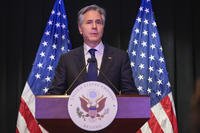As North Korea continues to play the DefCon game, it's time to analyze what kind of military response the U.S. might be able to mount should something really bad happen. Bottom line: the response would probably have to rely on the fear factor of killing some of the 58,000 U.S. troops in South Korea, on what China would do and how the good ole international community would react. The reasons for that prognosis are fairly simple: the US has committed so much of its troops and treasure to Iraq and Afghanistan for so long that the conventional military has little stretch left in it.
The North Korea situation is clearly at the point where serious may become deadly. Defense Secretary Robert Gates rose in Singapore to declare that, “We will not stand idly by as North Korea builds the capability to wreak destruction on any target in Asia — or on us.” There are whispers about that US intelligence assets have detected the early stages of ground force mobilization by the North Koreans, but I stress those are still rumors. And today there are reports that North Korea is readying another ICBM test, which would send ripples of tension throughout the Pacific basin.
The Financial Times quoted Gates about the game played by North Koreans. "We have to be very tough minded about this. Everyone in this room is familiar with the tactics that the North Koreans use,” he said. "They create a crisis and then the rest of us pay a price to return to the status quo ante … I am tired of buying the same horse twice."
While few in the military are willing to talk about specific options being considered, the strained US military will find it difficult to respond quickly to any major provocation by North Korea. Here's the evidence. Item: Gen. George Casey, Army chief of staff, said last week that it would take about 90 days to get more troops to the Korean peninsula.
Item: During an April 22 hearing before the Senate Armed Services Committee Army Gen. Peter Chiarelli, vice chief of staff, and Gen. James Amos, assistant commandant of the Marines, delivered a sobering assessment in direct response to questions about the country's ability to respond to a North Korean crisis.
“I think it would be very difficult, challenging — I don’t think there is any question about it,” Amos said, adding that it would “emasculate all our strategic reserves.” For those who remember Gen. Macarthur's brilliant gambit at Inchon (pictured), Amos delivered a truly worrying assessment that has since been echoed by the deputy commandant. The toll of the last seven years of combat has forced the service to sacrifice its traditionally vaunted capabilities in combined arms operations and large-scale amphibious operations to be the excellent counterinsurgency force it has become.
The current deployments to Afghanistan and the toll of Iraq have done nothing to lighten that load, Amos made clear.
The stress of combat and the greatly increased use of air and ground equipment are beginning to affect the availability of “critical” equipment, he said.
Item: When the Corps sent the 2nd MEB to Afghanistan it had to pull 14 percent of the equipment needed from non-deployed units. And in a move that showed just how little room for maneuver the Marines have, 51 percent of the equipment for the brigade rolled right off of production lines to the Marines, not from inventory.
Marine aircraft “are flying at utilization rates far beyond those for which they were designed. We are nearly tripling the utilization rates of our workhorses – the F/A-18C and D; the KC-130 cargo and aerial refueling platform; our EA-6B electronic warfare aircraft; and even the new MV-22 Osprey,” Amos said in his prepared testimony. To keep deployed squadrons fully equipped the Corps has cut aircraft and parts to non-deployed squadrons. In all, the service is short 248 aircraft.
The Army is in slightly better shape, but only because it so much larger. But there is little wiggle room, Chiarelli made chillingly clear: “We are consuming our readiness as soon as we get it.”
On top of all this, consider how many strategic assets such as squadrons of F-22, B-1 and B-52 stand ready to respond in the Korean theater. The exact answer is classified but there aren't many.








